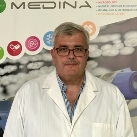Marine Drugs Research in Spain 2nd Edition
A special issue of Marine Drugs (ISSN 1660-3397). This special issue belongs to the section "Marine Pharmacology".
Deadline for manuscript submissions: closed (30 June 2024) | Viewed by 6890
Special Issue Editors
Interests: chromatography; mass spectrometry; liquid chromatography; natural product chemistry; nuclear magnetic resonance; bioactivity; medicinal chemistry; NMR structure elucidation; LC-MS/MS; MIC; compound isolation; structure elucidation; natural products; metabolite identification; alkaloids; pharmacognosy; bioassays; HPLC-UV; bioactive secondary metabolites; marine natural products
Special Issues, Collections and Topics in MDPI journals
Interests: organic structure elucidation; stereochemistry and configurational analysis by NMR and computational methods; organic synthesis of natural products; siderophores; pathogenic bacteria in aquaculture
Special Issues, Collections and Topics in MDPI journals
Interests: marine natural products; marine toxins; marine polyether; marine microalgae; biosynthesis; Laurencia; antiparasitic substances; phosphatase inhibitors
Special Issues, Collections and Topics in MDPI journals
Special Issue Information
Dear Colleagues,
Spain is outlined by nearly 8000 km of coastline, which makes it one of the most important countries to study the chemistry and the biology of marine life. The first marine natural product reports from Spain date back to the early 1970s, with publications on marine organisms collected in the Atlantic Ocean authored by one of the pioneers of marine natural products in Spain, the late Prof. Antonio Gonzalez from the University of La Laguna in the Canary Islands. These publications constituted the seed for the study of marine organisms and their natural products by some other research groups, including the universities of Cadiz, Salamanca, Santiago de Compostela, and CSIC.
Following the success of the first Special Issue on “Marine Drugs Research in Spain”, which was composed of more than 10 published papers, we will continue paying tribute to these marine research schools with this second edition, providing Spanish researchers and institutions with a platform for publishing biomedical and chemical studies on substances of marine origin. We welcome papers focused on the isolation, structure elucidation and synthesis of marine compounds, metabolomics of marine extracts, biosynthetic aspects of marine metabolites and/or any other biological aspects of marine macro- or microorganism research.
Dr. Fernando Reyes
Prof. Dr. Jaime Rodríguez
Dr. Javier Fernández
Guest Editors
Manuscript Submission Information
Manuscripts should be submitted online at www.mdpi.com by registering and logging in to this website. Once you are registered, click here to go to the submission form. Manuscripts can be submitted until the deadline. All submissions that pass pre-check are peer-reviewed. Accepted papers will be published continuously in the journal (as soon as accepted) and will be listed together on the special issue website. Research articles, review articles as well as short communications are invited. For planned papers, a title and short abstract (about 100 words) can be sent to the Editorial Office for announcement on this website.
Submitted manuscripts should not have been published previously, nor be under consideration for publication elsewhere (except conference proceedings papers). All manuscripts are thoroughly refereed through a single-blind peer-review process. A guide for authors and other relevant information for submission of manuscripts is available on the Instructions for Authors page. Marine Drugs is an international peer-reviewed open access monthly journal published by MDPI.
Please visit the Instructions for Authors page before submitting a manuscript. The Article Processing Charge (APC) for publication in this open access journal is 2900 CHF (Swiss Francs). Submitted papers should be well formatted and use good English. Authors may use MDPI's English editing service prior to publication or during author revisions.
Keywords
- structure elucidation
- isolation
- synthesis
- metabolomics
- biosynthesis
- bioactive compounds
Benefits of Publishing in a Special Issue
- Ease of navigation: Grouping papers by topic helps scholars navigate broad scope journals more efficiently.
- Greater discoverability: Special Issues support the reach and impact of scientific research. Articles in Special Issues are more discoverable and cited more frequently.
- Expansion of research network: Special Issues facilitate connections among authors, fostering scientific collaborations.
- External promotion: Articles in Special Issues are often promoted through the journal's social media, increasing their visibility.
- e-Book format: Special Issues with more than 10 articles can be published as dedicated e-books, ensuring wide and rapid dissemination.
Further information on MDPI's Special Issue polices can be found here.








